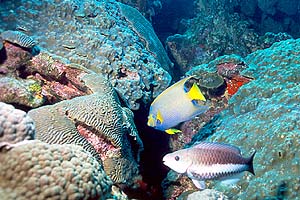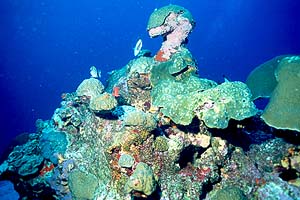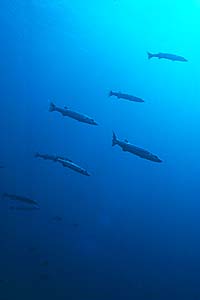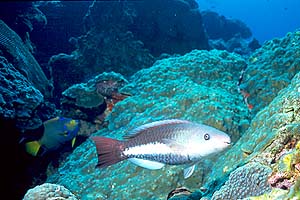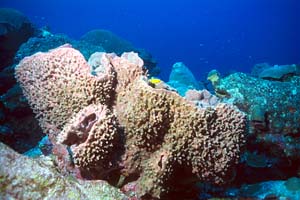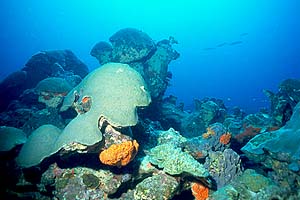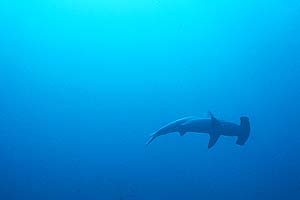February 1999 Flower Gardens Trip Report
Text and images Copyright (C) 1999 David M. Read. All rights reserved.
|
This was my first trip working the boats as a divemaster, and what a trip
it was. The conditions were rough, the air was cold, and I was only slightly overwhelmed
by the whole experience. However, the lure of hammerhead sharks was too strong, and I jumped at the chance to make the trip, disregarding the conditions. The trip had its good moments and its bad moments, but mostly I enjoyed the diving and the sights. |
The worst part of the experience was definitely at East Bank late on the first day. When I did the check dive, the current was blowing so hard that I never let go of the mooring line. Before I started the dive, I noticed that the port side down line was hanging at a 30-degree angle due to the current pushing on it--and there was a 40-pound weight on the bottom of the line! Taking this as a sign, I entered the water from the forward gate, near the bow, and still almost couldn't swim the 15 feet to the mooring line. Once I reached the mooring line, I held on for dear life until the other divemaster threw me the side line, and I started my dive. At 35 feet, I stopped and tied the side line to the morring line, and proceeded to the bottom for a temperature, visibility, and current check. The current slacked a little near the bottom, but it was blazing between 55 feet and the surface. I kept a death-grip on the mooring line, because I knew I'd never make it back to the boat otherwise. I let go only at the very bottom, and then I swam only 20 feet from the mooring line before turning tail. I followed the mooring line all the way up to the side line, and then followed the side line all the way back to the boat. Back on the boat, it was time to brief the divers. Literally, I begged them not to do the dive. I told them about the current (2+ knots down to 55 feet), the poor visibility (30 feet, max, which is awful for the Gardens), and the water temperature (69 F). I pleaded with all newer divers to stay out of the water. I begged anyone intent on making the dive not to let go of the mooring line. I advised them that if they let go of the mooring line, they shouldn't go more than 10 or 20 feet from it. Despite the gloom-and-doom picture, 10 of the 30+ passengers decided to make the dive anyway. I ended up having to go get 5 of them in the chase boat afterwards. Moral of the story: when your divemaster is scared, you should be, too! |
|
|
The worst part about it was the chase boat can not hold
more than 2 or three divers. The 5 divers who came up away from the boat all came up
far enough off the boat that they couldn't reach the trailing line--and I had set all 350
feet of it! So into the zodiac I went. I got the first group (2 divers)
pretty quickly, maybe within 5 minutes of when they surfaced. The 4-foot waves at
the surface made the return trip to the Fling exciting but slow. 5 minutes
later, I was ready to go after the second batch (3 divers). Knowing that the zodiac
was not up to hauling me plus another 3 divers in those conditions, I had the dive deck
crew radio the other boat (the Spree) to send their zodiac out, as well.
Off I went. The problem was: in the 10 minutes it took me to bring the first pair back
to the boat and radio the Spree, the other group of 3 had disappeared from
sight. The lookouts on the Fling's sun deck could see them, but the divers
had drifted so far from the Fling (roughly half a mile is my estimate) that I
couldn't see the observer's hand signals for direction. Worse still, the waves were
high enough that they disappeared into the troughs. None of the divers had a safety
sausage, and none of them remembered the 'wave-a-fin-over-your-head' trick, despite
my mentioning it during the trip briefing. Oh well. |
| I knew where the missing divers were when I had last seen them, so I went
there. Then I watched my own drifting for a few seconds to figure out which way the
current was blowing (I used Mobil HI-389, a nearby oil rig, as a reference), and took off
in the same direction. After zig-zagging across the current vector for a few minutes
(the Fling's captain later told me that he saw me zig-zagging and thought
"oh, shit!", knowing that meant I had lost the divers), I finally saw the
divers, a tiny little cluster of dots way off downcurrent. The only way I spotted
them was because one diver had some neon-yellow accents on his wetsuit shoulders. A
few minutes later, I picked them up, and we waited for the Spree's chase boat to
catch up with us. We were almost a mile from the Fling when I got them!!
The other zodiac took the two men (it had a more powerful motor), and I took the woman.
It took us almost 15 minutes to slog back upcurrent to the boats. There are several morals to this story. First (a repeat, I know, but it's worth repeating): when your divemaster is scared, you should be, too! Second: never dive in the open ocean without a safety sasusage or some sort of tall signaling device. When you're in the troughs, the boats can't see you. |
|
| You may be asking yourself: if the conditions are so nasty out there in
February, why do people dive it? Good question. Here's the good answer: hammerheads! Hammerhead sharks migrate through the area in February and March. There's a very good chance of seeing them on the spring trips. Of course, there's an even better chance that your trip will get cancelled due to bad weather, but that's a different story. This trip did not disappoint, with plenty of sharks on at least a couple of dives. I'll leave the details for the dive log. |
Dive Log Excerpts
Dive #1: West Bank, Buoy #5. Just doing the check dive to set the side line. Saw a bunch of barracuda, chub, and black durgons. Otherwise quiet.
Dive #2: West Bank, Buoy #5. SHARKS! Saw 7 hammerheads cruising the reef. Big, majestic animals, they generally didn't seem to mind our presence. Some were huge (> 8 feet); some were smaller. Also saw a lone spotted eagle ray, about 6 feet across. Also saw a couple of giant (4-foot) amberjacks, and a huge school of smaller horseye jacks. Lots of barracuda, too, all pointing into the current.
Dive #3: East Bank, Buoy #7. Check dive. Absolutely screaming current, very bad vis.
Dive #4: Stetson Bank, Buoy #2: Stetson seems to be recovering from the bleaching I saw last fall, although there's still quite a bit of bleached-out fire coral.
Dive Log Details
| Dive # | Location | Depth | Time | Comments |
| 1 | West Bank, Buoy #5 | 71 | 0:15 | |
| 2 | West Bank, Buoy #5 | 78 | 0:40 | |
| 3 | East Bank, Buoy #7 | 75 | 0:20 | |
| 4 | Stetson Bank, Buoy #2 | 82 | 0:28 |
Last modified August 4, 1999
About | UW Photos | Scuba Picture Uv the Day | Flower Gardens | Aquashot | Trip Reports | RSDiver | Photo Instruction | News | Desktop/Screensaver Images | Site Map |
||
